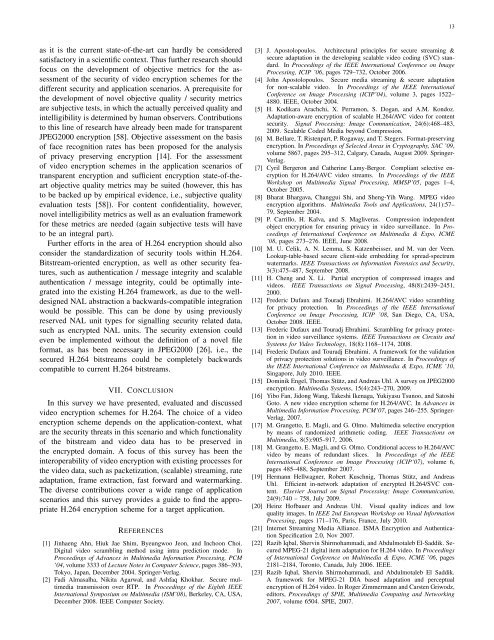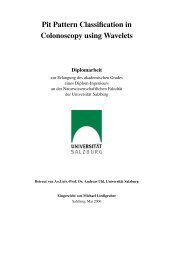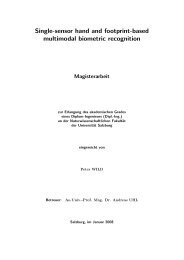13as it is the current state-<strong>of</strong>-the-art can hardly be consideredsatisfactory in a scientific context. Thus further research shouldfocus on the development <strong>of</strong> objective metrics for the assessment<strong>of</strong> the security <strong>of</strong> video encryption schemes for thedifferent security and application scenarios. A prerequisite forthe development <strong>of</strong> novel objective quality / security metricsare subjective tests, in which the actually perceived quality andintelligibility is determined by human observers. Contributionsto this line <strong>of</strong> research have already been made for transparentJPEG2000 encryption [58]. Objective assessment on the basis<strong>of</strong> face recognition rates has been proposed for the analysis<strong>of</strong> privacy preserving encryption [14]. For the assessment<strong>of</strong> video encryption schemes in the application scenarios <strong>of</strong>transparent encryption and sufficient encryption state-<strong>of</strong>-theartobjective quality metrics may be suited (however, this hasto be backed up by empirical evidence, i.e., subjective qualityevaluation tests [58]). For content confidentiality, however,novel intelligibility metrics as well as an evaluation frameworkfor these metrics are needed (again subjective tests will haveto be an integral part).Further efforts in the area <strong>of</strong> <strong>H.264</strong> encryption should alsoconsider the standardization <strong>of</strong> security tools within <strong>H.264</strong>.Bitstream-oriented encryption, as well as other security features,such as authentication / message integrity and scalableauthentication / message integrity, could be optimally integratedinto the existing <strong>H.264</strong> framework, as due to the welldesignedNAL abstraction a backwards-compatible integrationwould be possible. This can be done by using previouslyreserved NAL unit types for signalling security related data,such as encrypted NAL units. The security extension couldeven be implemented without the definition <strong>of</strong> a novel fileformat, as has been necessary in JPEG2000 [26], i.e., thesecured <strong>H.264</strong> bitstreams could be completely backwardscompatible to current <strong>H.264</strong> bitstreams.VII. CONCLUSIONIn this survey we have presented, evaluated and discussedvideo encryption schemes for <strong>H.264</strong>. The choice <strong>of</strong> a videoencryption scheme depends on the application-context, whatare the security threats in this scenario and which functionality<strong>of</strong> the bitstream and video data has to be preserved inthe encrypted domain. A focus <strong>of</strong> this survey has been theinteroperability <strong>of</strong> video encryption with existing processes forthe video data, such as packetization, (scalable) streaming, rateadaptation, frame extraction, fast forward and watermarking.The diverse contributions cover a wide range <strong>of</strong> applicationscenarios and this survey provides a guide to find the appropriate<strong>H.264</strong> encryption scheme for a target application.REFERENCES[1] Jinhaeng Ahn, Hiuk Jae Shim, Byeungwoo Jeon, and Inchoon Choi.Digital video scrambling method using intra prediction mode. InProceedings <strong>of</strong> Advances in Multimedia Information Processing, PCM’04, volume 3333 <strong>of</strong> Lecture Notes in Computer Science, pages 386–393,Tokyo, Japan, December 2004. Springer-Verlag.[2] Fadi Almasalha, Nikita Agarwal, and Ashfaq Khokhar. Secure multimediatransmission over RTP. In Proceedings <strong>of</strong> the Eighth IEEEInternational Symposium on Multimedia (ISM’08), Berkeley, CA, USA,December 2008. IEEE Computer Society.[3] J. Apostolopoulos. Architectural principles for secure streaming &secure adaptation in the developing scalable video coding (<strong>SVC</strong>) standard.In Proceedings <strong>of</strong> the IEEE International Conference on ImageProcessing, ICIP ’06, pages 729–732, October 2006.[4] John Apostolopoulos. Secure media streaming & secure adaptationfor non-scalable video. In Proceedings <strong>of</strong> the IEEE InternationalConference on Image Processing (ICIP’04), volume 3, pages 1522–4880. IEEE, October 2004.[5] H. Kodikara Arachchi, X. Perramon, S. Dogan, and A.M. Kondoz.Adaptation-aware encryption <strong>of</strong> scalable <strong>H.264</strong>/<strong>AVC</strong> video for contentsecurity. Signal Processing: Image Communication, 24(6):468–483,2009. Scalable Coded Media beyond Compression.[6] M. Bellare, T. Ristenpart, P. Rogaway, and T. Stegers. Format-preservingencryption. In Proceedings <strong>of</strong> Selected Areas in Cryptography, SAC ’09,volume 5867, pages 295–312, Calgary, Canada, August 2009. Springer-Verlag.[7] Cyril Bergeron and Catherine Lamy-Bergor. Compliant selective encryptionfor <strong>H.264</strong>/<strong>AVC</strong> video streams. In Proceedings <strong>of</strong> the IEEEWorkshop on Multimedia Signal Processing, MMSP’05, pages 1–4,October 2005.[8] Bharat Bhargava, Changgui Shi, and Sheng-Yih Wang. MPEG videoencryption algorithms. Multimedia Tools and Applications, 24(1):57–79, September 2004.[9] P. Carrillo, H. Kalva, and S. Magliveras. Compression independentobject encryption for ensuring privacy in video surveillance. In Proceedings<strong>of</strong> International Conference on Multimedia & Expo, ICME’08, pages 273–276. IEEE, June 2008.[10] M. U. Celik, A. N. Lemma, S. Katzenbeisser, and M. van der Veen.Lookup-table-based secure client-side embedding for spread-spectrumwatermarks. IEEE Transactions on Information Forensics and Security,3(3):475–487, September 2008.[11] H. Cheng and X. Li. Partial encryption <strong>of</strong> compressed images andvideos. IEEE Transactions on Signal Processing, 48(8):2439–2451,2000.[12] Frederic Dufaux and Touradj Ebrahimi. <strong>H.264</strong>/<strong>AVC</strong> video scramblingfor privacy protection. In Proceedings <strong>of</strong> the IEEE InternationalConference on Image Processing, ICIP ’08, San Diego, CA, USA,October 2008. IEEE.[13] Frederic Dufaux and Touradj Ebrahimi. Scrambling for privacy protectionin video surveillance systems. IEEE Transactions on Circuits andSystems for Video Technology, 18(8):1168–1174, 2008.[14] Frederic Dufaux and Touradj Ebrahimi. A framework for the validation<strong>of</strong> privacy protection solutions in video surveillance. In Proceedings <strong>of</strong>the IEEE International Conference on Multimedia & Expo, ICME ’10,Singapore, July 2010. IEEE.[15] Dominik Engel, Thomas Stütz, and Andreas Uhl. A survey on JPEG2000encryption. Multimedia Systems, 15(4):243–270, 2009.[16] Yibo Fan, Jidong Wang, Takeshi Ikenaga, Yukiyasu Tsunoo, and SatoshiGoto. A new video encryption scheme for <strong>H.264</strong>/<strong>AVC</strong>. In Advances inMultimedia Information Processing, PCM’07, pages 246–255. Springer-Verlag, 2007.[17] M. Grangetto, E. Magli, and G. Olmo. Multimedia selective encryptionby means <strong>of</strong> randomized arithmetic coding. IEEE Transactions onMultimedia, 8(5):905–917, 2006.[18] M. Grangetto, E. Magli, and G. Olmo. Conditional access to <strong>H.264</strong>/<strong>AVC</strong>video by means <strong>of</strong> redundant slices. In Proceedings <strong>of</strong> the IEEEInternational Conference on Image Processing (ICIP’07), volume 6,pages 485–488, September 2007.[19] Hermann Hellwagner, Robert Kuschnig, Thomas Stütz, and AndreasUhl. Efficient in-network adaptation <strong>of</strong> encrypted <strong>H.264</strong>/<strong>SVC</strong> content.Elsevier Journal on Signal Processing: Image Communication,24(9):740 – 758, July 2009.[20] Heinz H<strong>of</strong>bauer and Andreas Uhl. Visual quality indices and lowquality images. In IEEE 2nd European Workshop on Visual InformationProcessing, pages 171–176, Paris, France, July 2010.[21] Internet Streaming Media Alliance. ISMA <strong>Encryption</strong> and AuthenticationSpecification 2.0, Nov 2007.[22] Razib Iqbal, Shervin Shirmohammadi, and Abdulmotaleb El-Saddik. SecuredMPEG-21 digital item adaptation for <strong>H.264</strong> video. In Proceedings<strong>of</strong> International Conference on Multimedia & Expo, ICME ’06, pages2181–2184, Toronto, Canada, July 2006. IEEE.[23] Razib Iqbal, Shervin Shirmohammadi, and Abdulmotaleb El Saddik.A framework for MPEG-21 DIA based adaptation and perceptualencryption <strong>of</strong> <strong>H.264</strong> video. In Roger Zimmermann and Carsten Griwodz,editors, Proceedings <strong>of</strong> SPIE, Multimedia Computing and Networking2007, volume 6504. SPIE, 2007.
14[24] Razib Iqbal, Shervin Shirmohammadi, Abdulmotaleb El Saddik, andJiying Zhao. Compressed-domain video processing for adaptation,encryption, and authentication. IEEE Multimedia, 15(2):38–50, April2008.[25] ISO/IEC 15444-12. Information technology – JPEG2000 image codingsystem, Part 12: ISO base media file format, April 2005.[26] ISO/IEC 15444-8. Information technology – JPEG2000 image codingsystem, Part 8: Secure JPEG2000, April 2007.[27] ITU-T <strong>H.264</strong>. Advanced video coding for generic audivisual services,November 2007.[28] Y. Kim, S. Yin, T. Bae, and Y. Ro. A selective video encryptionfor the region <strong>of</strong> interest in scalable video coding. In Proceedings <strong>of</strong>the TENCON 2007 - IEEE Region 10 Conference, pages 1–4, Taipei,Taiwan, October 2007.[29] R. Kuschnig, I. K<strong>of</strong>ler, M. Ransburg, and H. Hellwagner. Design optionsand comparison <strong>of</strong> in-network <strong>H.264</strong>/<strong>SVC</strong> adaptation. Journal <strong>of</strong> VisualCommunication and Image Representation, pages 529–542, September2008.[30] Sang Gu Kwon, Woong Il Choi, and Byeungwoo Jeon. Digital videoscrambling using motion vector and slice relocation. In Proceedings<strong>of</strong> Second International Conference <strong>of</strong> Image Analysis and Recognition,ICIAR’05, volume 3656 <strong>of</strong> Lecture Notes in Computer Science, pages207–214, Toronto, Canada, September 2005. Springer-Verlag.[31] Chang-Youl Lee, Hyun-Jun Choi, Young-Ho Seo, and Dong-Wook Kim.A blind watermarking algorithm for <strong>H.264</strong>/<strong>AVC</strong> using entropy coder(CABAC). In Proceedings <strong>of</strong> the 7th International Workshop on ImageAnalysis for Multimedia Interactive Services, WIAMIS ’06, Incheon,Korea, April 2006.[32] Ho-Jae Lee and Jeho Nam. Low complexity controllable scrambler/descramblerfor <strong>H.264</strong>/<strong>AVC</strong> in compressed domain. In Klara Nahrstedt,Matthew Turk, Yong Rui, Wolfgang Klas, and Ketan Mayer-Patel,editors, Proceedings <strong>of</strong> ACM Multimedia 2006, pages 93–96. ACM,2006.[33] Chunhua Li, Xinxin Zhou, and Yuzhuo Zhong. NAL level encryptionfor scalable video coding. In Advances in Multimedia InformationProcessing, PCM’08, pages 496–505. Springer-Verlag, December 2008.[34] Shujun Li, Guanrong Chen, Albert Cheung, Bharat Bhargava, andKwok-Tung Lo. On the design <strong>of</strong> perceptual MPEG-video encryptionalgorithms. IEEE Transactions on Circuits and Systems for VideoTechnology, 17(2):214–223, 2007.[35] Xin Li, Bahadir Gunturk, and Lei Zhang. Image demosaicing: Asystematic survey. In Proceedings <strong>of</strong> SPIE, Visual Communications andImage Processing, VCIP ’08, volume 6822, pages 68221J–68221J–15,San Jose, CA, USA, January 2008. SPIE.[36] Yuan Li, Liwei Liang, Zhaopin Su, and Jianguo Jiang. A new videoencryption algorithm for <strong>H.264</strong>. In Proceedings <strong>of</strong> the Fifth InternationalConference on Information, Communications and Signal Processing,ICICS’05, pages 1121– 1124. IEEE, December 2005.[37] Shiguo Lian, Zhongxuan Liu, Zhen Ren, and Haila Wang. Secureadvanced video coding based on selective encryption algorithms. IEEETransactions on Consumer Electronics, 52(2):621–629, 2006.[38] Shiguo Lian, Zhongxuan Liu, Zhen Ren, and Haila Wang. Commutativeencryption and watermarking in video compression. IEEE Transactionson Circuits and Systems for Video Technology, 17(6):774–778, 2007.[39] Shiguo Lian, Zhongxuan Liu, Zhen Ren, and Zhiquan Wang. Selectivevideo encryption based on advanced video coding. In Proceedings <strong>of</strong>the Pacific-Rim Conference on Multimedia, Advances in MultimediaInformation Processing, PCM ’05, volume 3768 <strong>of</strong> Lecture Notes inComputer Science, pages 281–290. Springer, 2005.[40] Shiguo Lian, Jinsheng Sun, Guangjie Liu, and Zhiquan Wang. Efficientvideo encryption scheme based on advanced video coding. MultimediaTools and Applications, 38(1):75–89, March 2008.[41] Fuwen Liu and Hartmut Koenig. A survey <strong>of</strong> video encryptionalgorithms. Computers & Security, 29(1):3–15, 2010.[42] Yang Liu, Chun Yuan, and Yuzhuo Zhong. A new digital rightsmanagement system in mobile applications using <strong>H.264</strong> encryption. InProceedings <strong>of</strong> the 9th International Conference on Advanced CommunicationTechnology, volume 1, pages 583–586, February 2007.[43] E. Magli, M. Grangetto, and G. Olmo. Conditional access techniquesfor <strong>H.264</strong>/<strong>AVC</strong> and <strong>H.264</strong>/<strong>SVC</strong> compressed video. IEEE Transactionson Circuits and Systems for Video Technology, 2008. to appear.[44] Enrico Magli, Marco Grangetto, and Gabriella Olmo. Conditional accessto <strong>H.264</strong>/<strong>AVC</strong> video with drift control. In Proceedings <strong>of</strong> the IEEEInternational Conference on Multimedia and Expo, ICME’06. IEEE,July 2006.[45] Yinian Mao and Min Wu. A joint signal processing and cryptographicapproach to multimedia encryption. IEEE Transactions on ImageProcessing, 15(7):2061–2075, July 2006.[46] Ayoub Massoudi, Frédéric Lefèbvre, Christophe De Vleeschouwer,Benoit Macq, and Jean-Jacques Quisquater. Overview on selectiveencryption <strong>of</strong> image and video, challenges and perspectives.EURASIP Journal on Information Security, 2008(Article ID179290):doi:10.1155/2008/179290, 18 pages, 2008.[47] Peter Meerwald and Andreas Uhl. Robust watermarking <strong>of</strong> <strong>H.264</strong>-encoded video: Extension to <strong>SVC</strong>. In Proceedings <strong>of</strong> the Sixth InternationalConference on Intelligent Information Hiding and MultimediaSignal Processing, IIH-MSP ’10, pages 82–85, Darmstadt, Germany,October 2010.[48] Cai Mian, Jia Jia, and Yan Lei. An <strong>H.264</strong> video encryption algorithmbased on entropy coding. In Proceedings <strong>of</strong> the Third InternationalConference on International Information Hiding and Multimedia SignalProcessing, IIH-MSP’07, pages 41–44, Washington, DC, USA, 2007.IEEE Computer Society.[49] National Institute <strong>of</strong> Standards and Technology. FIPS-197 - advancedencryption standard (AES), November 2001.[50] M. Noorkami and R. M. Mersereau. Digital video watermarking in P-frames. In Proceedings <strong>of</strong> SPIE, Conference on Security, Steganographyand Watermarking <strong>of</strong> Multimedia Contents IX, volume 6505, San Jose,CA, USA, January 2007. SPIE.[51] Lintian Qiao and Klara Nahrstedt. Comparison <strong>of</strong> MPEG encryptionalgorithms. International Journal on Computers and Graphics (SpecialIssue on Data Security in Image Communication and Networks),22(3):437–444, 1998.[52] I. E. G. Richardson. <strong>H.264</strong> and MPEG-4 video compression: videocoding for next generation multimedia. Wiley & Sons, 2003.[53] A. Said. Measuring the strength <strong>of</strong> partial encryption schemes. InProceedings <strong>of</strong> the IEEE International Conference on Image Processing(ICIP’05), volume 2, September 2005.[54] H. Schwarz, D. Marpe, and T. Wiegand. Overview <strong>of</strong> the scalable videocoding extension <strong>of</strong> the <strong>H.264</strong>/<strong>AVC</strong> standard. IEEE Transactions onCircuits and Systems for Video Technology, 17(9):1103–1120, September2007.[55] Andrew Senior, editor. Protecting Privacy in Video Surveillance.Springer, 2009.[56] Z. Shahid, M. Chaumont, and W. Puech. Fast protection <strong>of</strong> <strong>H.264</strong>/<strong>AVC</strong>by selective encryption <strong>of</strong> CABAC. In Proceedings <strong>of</strong> the IEEEInternational Conference on Multimedia & Expo, ICME ’09, Cancun,Mexico, June 2009. IEEE.[57] Susanna Spinsante, Franco Chiaraluce, and Ennio Gambi. Maskingvideo information by partial encryption <strong>of</strong> <strong>H.264</strong>/<strong>AVC</strong> coding parameters.In Proceedings <strong>of</strong> the 13th European Signal ProciessingConference, EUSIPCO’05. EURASIP, September 2005.[58] Thomas Stütz, Vinod Pankajakshan, Florent Autrusseau, Andreas Uhl,and Heinz H<strong>of</strong>bauer. Subjective and objective quality assessment <strong>of</strong>transparently encrypted JPEG2000 images. In Proceedings <strong>of</strong> theACM Multimedia and Security Workshop (MMSEC ’10), Rome, Italy,September 2010. ACM. accepted.[59] Thomas Stütz and Andreas Uhl. Format-compliant encryption <strong>of</strong><strong>H.264</strong>/<strong>AVC</strong> and <strong>SVC</strong>. In Proceedings <strong>of</strong> the Eighth IEEE InternationalSymposium on Multimedia (ISM’08), Berkeley, CA, USA, December2008. IEEE Computer Society.[60] Thomas Stütz and Andreas Uhl. Efficient format-compliant encryption<strong>of</strong> regular languages: Block-based cycle-walking. In B. De Decker andI. Schaumller-Bichl, editors, Proceedings <strong>of</strong> the 11th Joint IFIP TC6 andTC11 Conference on Communications and Multimedia Security, CMS’10, volume 6109 <strong>of</strong> IFIP Advances in Information and CommunicationTechnology, pages 81 – 92, Linz, Austria, May 2010. Springer.[61] Thomas Stütz and Andreas Uhl. (In)secure multimedia transmissionover RTP. In Proceedings <strong>of</strong> the 18th European Signal Processing Conference,EUSIPCO ’10, Aarlborg, Danmark, August 2010. EURASIP.[62] Po-Chyi Su, Chih-Wei Hsu, and Ching-Yu Wu. A practical design<strong>of</strong> content protection for <strong>H.264</strong>/<strong>AVC</strong> compressed videos by selectiveencryption and fingerprinting. Multimedia Tools and Applications,January 2010. online publication.[63] Jing Sun, Zhengquan Xu, Jin Liu, and Ye Yao. An objective visual securityassessment for cipher-images based on local entropy. MultimediaTools and Applications, March 2010. online publication.[64] Jean-Baptiste Thomas, Gael Chareyron, and Alain Tremeau. Imagewatermarking based on a color quantization process. In Proceedings<strong>of</strong> the SPIE, volume 6506, San Jose, CA, USA, January 2007. SPIE.[65] Nithin Thomas, David Bull, and David Redmill. A novel <strong>H.264</strong> <strong>SVC</strong>encryption scheme for secure bit-rate transcoding. In Proceedings <strong>of</strong>








